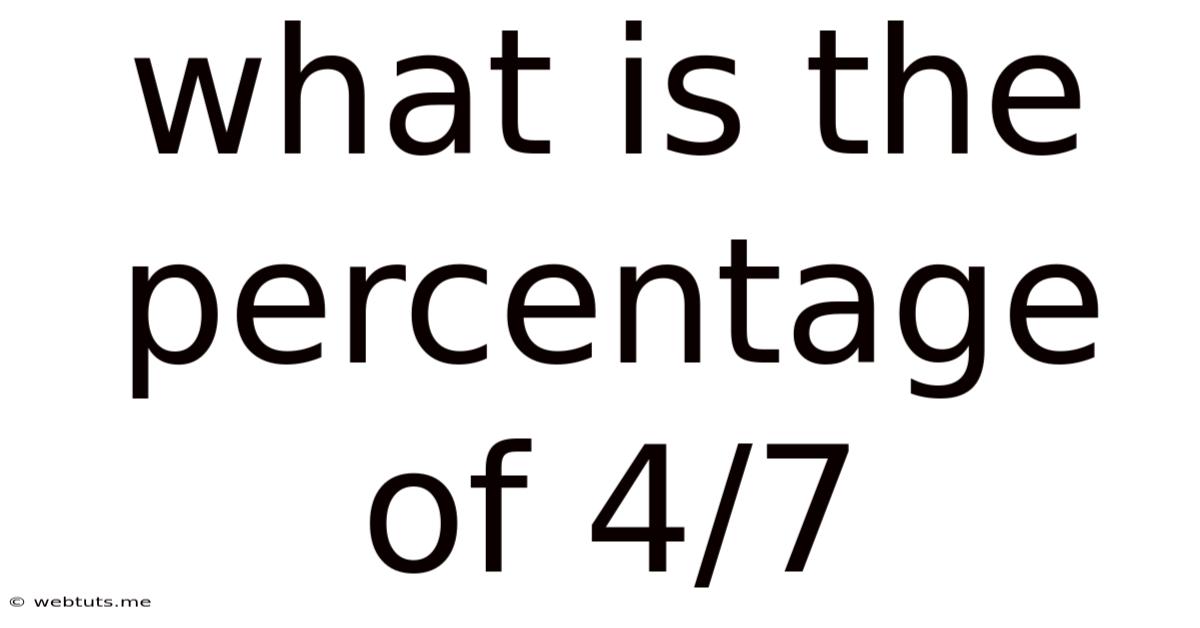What Is The Percentage Of 4/7
Webtuts
May 13, 2025 · 4 min read

Table of Contents
What is the Percentage of 4/7? A Deep Dive into Fractions and Percentages
Understanding fractions and their percentage equivalents is a fundamental skill in mathematics with widespread applications in daily life, from calculating discounts to understanding statistical data. This article will delve into the specifics of calculating the percentage equivalent of the fraction 4/7, exploring various methods and providing a comprehensive understanding of the underlying concepts. We'll also explore related concepts and offer practical examples to solidify your understanding.
Understanding Fractions and Percentages
Before we calculate the percentage of 4/7, let's briefly review the concepts of fractions and percentages.
Fractions: A fraction represents a part of a whole. It's expressed as a ratio of two numbers, the numerator (top number) and the denominator (bottom number). The denominator indicates the total number of equal parts, while the numerator indicates how many of those parts are being considered. For example, in the fraction 4/7, 4 is the numerator and 7 is the denominator. This means we're considering 4 parts out of a total of 7 equal parts.
Percentages: A percentage is a way of expressing a fraction or decimal as a portion of 100. The symbol % represents "per cent," which means "out of 100." Therefore, 50% means 50 out of 100, which is equivalent to the fraction 50/100 or the decimal 0.5.
Calculating the Percentage of 4/7: Method 1 - Direct Conversion
The most straightforward method to convert a fraction to a percentage is to perform the division and then multiply by 100.
-
Divide the numerator by the denominator: 4 ÷ 7 ≈ 0.5714
-
Multiply the result by 100: 0.5714 × 100 = 57.14%
Therefore, 4/7 is approximately 57.14%. Note that this is an approximation because the decimal representation of 4/7 is non-terminating (it continues infinitely).
Calculating the Percentage of 4/7: Method 2 - Using Proportions
Another way to approach this problem is using proportions. We can set up a proportion to find the equivalent percentage:
4/7 = x/100
To solve for x (the percentage), we cross-multiply:
7x = 400
x = 400/7 ≈ 57.14
Again, this confirms that 4/7 is approximately 57.14%.
Understanding the Approximation
It's crucial to understand that 57.14% is an approximation. The actual decimal representation of 4/7 is a repeating decimal: 0.571428571428... The repeating sequence "571428" continues infinitely. Therefore, any percentage calculation will be an approximation, depending on the level of precision required. For most practical purposes, 57.14% provides sufficient accuracy.
Rounding and Significant Figures
The level of accuracy you need will determine how you round your answer. If you need to round to the nearest whole number, 4/7 would be approximately 57%. If you need greater precision, you might use more decimal places, such as 57.14% or even 57.1429%. The appropriate level of rounding depends on the context of the problem. Understanding significant figures is also important for determining the accuracy of your calculations.
Practical Applications of Percentage Calculations
The ability to convert fractions to percentages is incredibly useful in various real-world scenarios:
1. Discount Calculations:
Imagine a store offering a 4/7 discount on an item. Knowing that 4/7 is approximately 57.14%, you can quickly calculate the discount amount.
2. Statistical Analysis:
Percentage calculations are essential in interpreting statistical data, such as survey results or the success rate of a particular process. For instance, if 4 out of 7 participants completed a survey, this represents approximately 57.14% completion rate.
3. Financial Calculations:
Understanding percentages is crucial for managing personal finances, such as calculating interest rates, taxes, and investment returns.
4. Measurement Conversions:
Fractions and percentages are frequently used in various measurement conversions, particularly in scenarios involving scaling or ratios.
5. Recipe Scaling:
When scaling recipes up or down, understanding fractions and percentages is vital for maintaining the correct proportions of ingredients.
Advanced Concepts Related to Fractions and Percentages
While calculating the percentage of 4/7 is a relatively straightforward process, several related concepts can deepen your understanding:
-
Decimal Representation of Fractions: Understanding how to convert fractions to decimals and vice versa is fundamental.
-
Ratio and Proportion: These are closely related mathematical concepts that often involve percentage calculations.
-
Percentage Change: This involves calculating the percentage increase or decrease between two values.
-
Compound Interest: Understanding how interest accumulates over time, involving repeated percentage calculations.
-
Probability: Percentage calculations are essential in expressing probabilities, such as the likelihood of an event occurring.
Conclusion: Mastering Fractions and Percentages
Understanding how to convert fractions to percentages is a valuable mathematical skill applicable to countless situations. While the calculation of 4/7 as a percentage involves a simple division and multiplication, appreciating the nuances of approximation, rounding, and the broader mathematical context will significantly enhance your understanding and ability to solve more complex problems involving fractions and percentages. The ability to confidently perform these calculations is essential for success in various academic, professional, and personal endeavors. Remember that consistent practice is key to mastering these concepts and building a strong foundation in mathematics.
Latest Posts
Latest Posts
-
How Many Gallons In 1 5 Cubic Feet
May 13, 2025
-
1 8 Of A Yard Is How Many Inches
May 13, 2025
-
How Many Milligrams In 1 Pound
May 13, 2025
-
How Many Days Ago Was July 15
May 13, 2025
-
How Many Ounces Is Six Cups
May 13, 2025
Related Post
Thank you for visiting our website which covers about What Is The Percentage Of 4/7 . We hope the information provided has been useful to you. Feel free to contact us if you have any questions or need further assistance. See you next time and don't miss to bookmark.